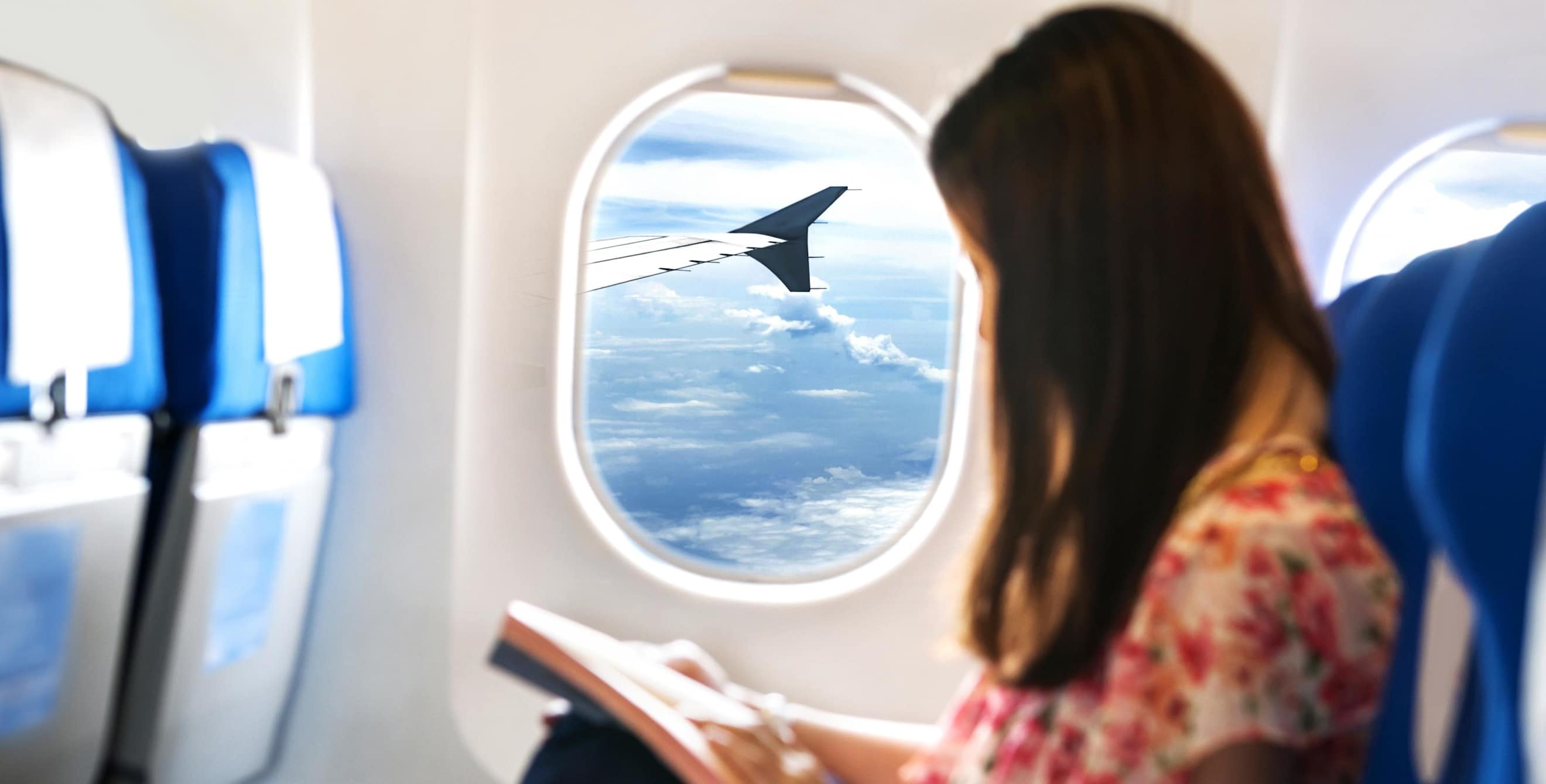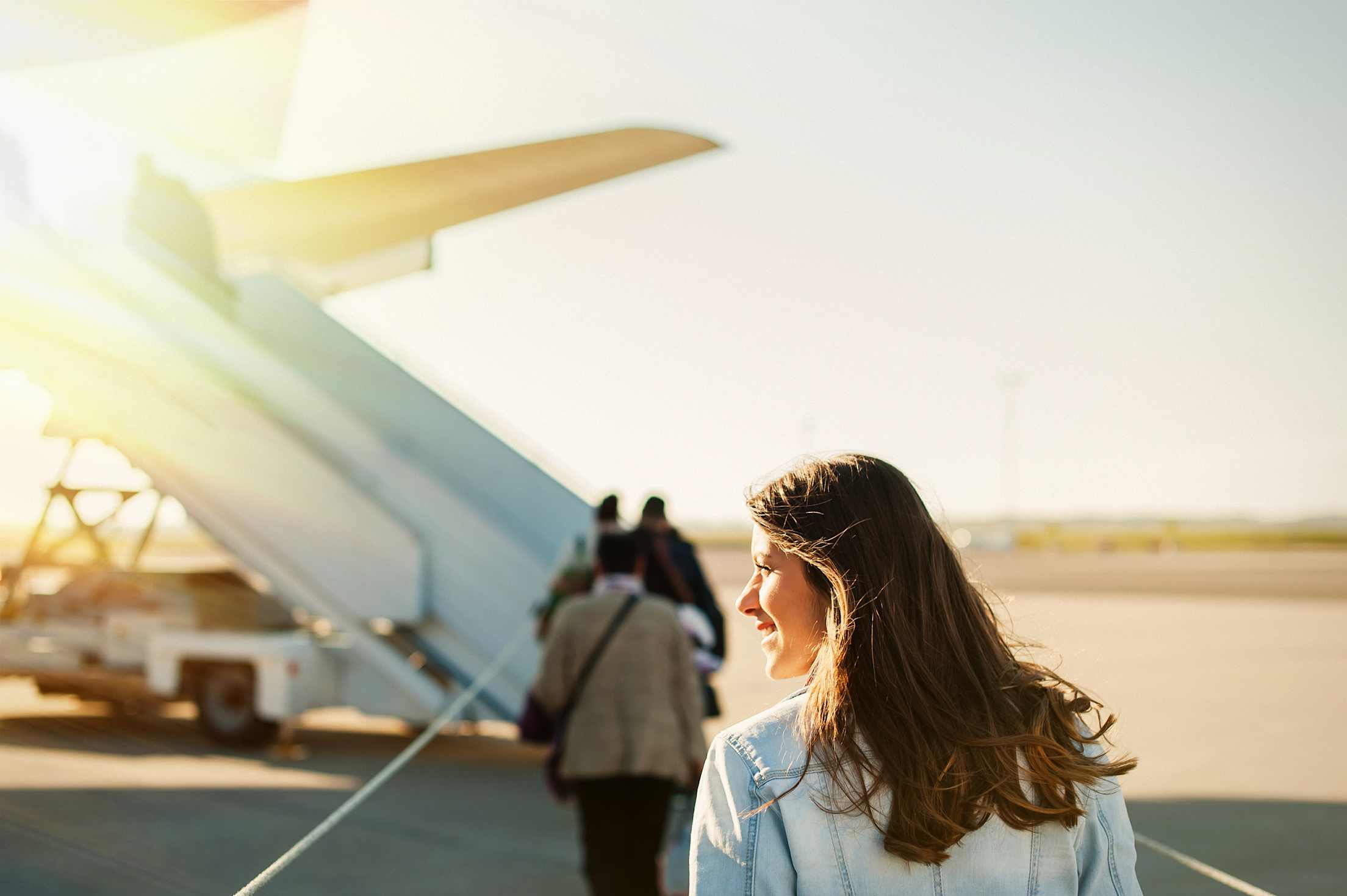
How to Overcome a Fear of Flying
Leave flight anxiety behind.

It started for me—as it does for many—with a bit of nerves. After two-plus decades of flying with a sense of wonder, I was traveling to Italy on my honeymoon and suddenly couldn’t shake the feeling of doom (and no, it had nothing to do with my marriage).
A few months later, on my next flight, that feeling of doom progressed to the sharp prick of fear, and a few months after that, full-on panic. When I hyperventilated to the point of nearly passing out, I decided it was time to get help.
I’m far from alone when it comes to feeling some butterflies in the stomach when flying. In a 2015 Chapman University survey, 15 percent of respondents reported some degree of nervousness about flying. And, according to Anxieties.com, it’s not uncommon to develop that fear as an adult, with the average age being—just as I was—27.
The good news: You don’t have to forgo travel due to your fear. Here are seven ways to manage a fear of flying.
1. Identify the cause of your fear.
“When you have a fear of flying it is important to identify your triggers,” says therapist Ashley McGirt. “Is it the thought of being in the air, the plane itself, flight staff, or overcrowded airports? Do you feel the onset of anxiety when you just look at planes or see them overhead? Identifying all of these things allow individuals to better overcome the anxiety. Once you identify the trigger, you can identify where the anxiety stems from.”
2. Educate yourself.
According to flight tracker FlightAware, on the average day in 2016 and 2017, there were 9,728 planes—carrying 1,270,406 people—flying the friendly skies. That’s a lot of planes taking off and landing safely every day, and when you consider that, it seems all the more rare when something goes wrong. And air disasters are objectively rare.
Newsweek says your odds of dying in a plane crash are one in 5 million to one in 20 million—compared to one in 3.7 million for being killed by a shark, and yet most people don’t experience panic attacks at the beach. Flying is safer than it has ever been, and while it’s hard to be rational during an irrational, emotional response to stress, it always helps me to think of all the other planes making their way safely through the skies at the same time.
Additionally, the more you know about the bumps and noises a plane makes, the more comfortable—or at least far less panicked—you may feel at every mechanical groan or bit of turbulence. “We fear the unknown,” says licensed psychotherapist Jason Eric Ross. “People often develop anxiety when they don't understand or have control, so they should inform themselves as much as they can about the flight process.”
Captain Tom Bunn, a licensed therapist and retired airline pilot who created the SOAR program to help fearful fliers, explains a part of the brain called the amygdala releases stress hormones in reaction to anything you’re not used to, and that includes moments like take-off and turbulence. “When you get on a highway and accelerate, you get pushed back in your seat so you’re used to experiencing that for a few seconds,” he explains, “but on an airplane it lasts for much longer.” This extended acceleration at takeoff and other factors like loud noises, changes in engine tone or volume, and unexpected lightheadedness during the flight can trigger the amygdala and cause your body to react with stress hormones, which make it very easy to believe that you're in trouble when you're not, according to Bunn.
3. Turn to an expert.
Many fearful fliers find help through therapy. “I suggest cognitive behavioral therapy to help get to the root of the fear,” says licensed professional counselor Ginger Courtney. “It's almost impossible to decide not to feel fear in the moment. However, if you investigate what beliefs and perceptions motivate the fear, you can then learn to make adjustments. Pair talk therapy with healthy behavioral habits for a thorough approach.”
There are also several well-regarded classes and books designed to help nervous fliers overcome—or at least better manage—their fears with a more DIY approach, including Captain Bunn’s SOAR program and its companion book, Soar: The Breakthrough Treatment for Fear of Flying. There’s also a free SOAR In-Flight app that includes tools like maps with turbulence forecasts and a G-force reader so fliers can be more informed about what’s actually happening on their flight, rather than imagining worst-case scenarios.
“In the program,” Captain Bunn says, “we teach people exercises that will help retrain their minds.” He suggests standing on a step side by side with another person, wrapping your arms around around each other’s waists, and then jumping to the floor. “For one tenth of a second, you’ll be in free fall,” Captain Bunn explains. “On a plane, free fall, like during turbulence, triggers the release of stress hormones, but in this case it won't because you have your arm around someone. Do it a few times and the amygdala will switch from thinking free fall is dangerous to thinking it’s fun. The effect is only temporary though, so do it the day of or before your flight.”
4. Find an ally.
On a flight to Las Vegas, strong winds and turbulence forced the pilot to abort our landing not one, but three times. By the second attempt, I was in tears, and had it not been for the kind woman next to me—who offered her hand and reassured me that as a Vegas local she’d landed in much worse turbulence—I probably would have been hysterical. Of course not all seatmates are as comforting, so Mary Jo Manzanares, a luxury travel writer who has been a flight attendant with a major U.S. carrier for over 30 years, recommends confiding in a flight attendant.
“Sometimes just voicing the fear can help, so feel free to mention it to your flight attendant,” she says. “Not only can they empathize—as some may have experienced that fear as well—but watching them calmly going about their duties throughout the flight can be reassuring. If they're not worried, you shouldn't be either."
Captain Bunn also recommends asking the gate agent if you can board early; once on board, explain to the flight attendant that you’re feeling nervous and ask if you can speak to the pilot. “One of the issues is giving up control,” he explains. “If you can meet the person who has control it's easier to give up control to them. You’ve seen the person who does have control and that gives you some assurance.”

5. Distract yourself.
You can’t always keep your brain from dreaming up doomsday scenarios, but you can sometimes give it something else to do. Whether it’s diving into a compelling novel, bingeing your favorite TV shows, knitting a complicated pattern, or working your brain with a crossword puzzle, finding something you can lose yourself in can help the time pass more quickly and keep you focused on something other than the unknown.
“Anxiety lives in the future, fueled by the ‘what if?’ thoughts that plague fearful fliers,” says Dr. Martin Seif, a founding member of the Anxiety and Depression Association of America, which offers additional resources for nervous fliers. “The more you can stay in the present, the less anxious you will be. Instead of "what if," focus on "what is." Anything that feels good, sounds good, tastes good, smells good, or looks good can help anchor you in the present. Flying becomes less fearful when you focus on manageable tasks in the present, and when you've practiced allowing time to pass.”
But, cautions Captain Bunn, distraction can be a fragile strategy if turbulence kicks in, thanks to that pesky amygdala. “It helps to picture that something is holding the plane up. We have a video called the jello exercise. When you walk across a room, air doesn't slow you down, but once you hit 20 mph on a bike it does. It’s as if the air is getting thicker. Get in a car, going 50 mph, push forward against the air and it's like putting your hand in a swimming pool. By the time you get to speeds like an airplane, the air is as thick as jello. Think about the plane like a piece of fruit suspended in jello. If you shake it, the fruit will jiggle, but it’s still suspended. If there's turbulence, remind yourself that you’re in jello and, even though your stress hormones are telling you otherwise, you're not in danger.”
6. Choose the right seat.
If turbulence is what sends you into an emotional tailspin, check in early or pay for seat selection so you can avoid the back of the plane, and aim for the middle or front. The plane’s center of gravity is typically at the wing, which makes the area around it the most stable and least affected by turbulence. Areas forward from the wing also experience less severe bumps than areas behind it.
Of course, if you can sit even farther up front—like all the way in business class—that can help, too. On the rare occasion I’ve been able to upgrade, I’ve found that the calmer, quieter atmosphere of business class, along with less cramped quarters, results in less anxiety for me. Additionally, I always make sure to get a window seat; especially during turbulence, it calms me if I’m able to look out and see that the plane is still the appropriate distance from the ground.
7. Get comfortable.
It’s no secret that plane seats are shrinking, flights are often packed full, and reports of both airlines and passengers behaving badly are frequently in the news—in short, even without anxiety, few people find flying to be a very pleasant experience. Any comfort you can eek out may help. At the very least, avoid extreme discomfort as this can add to feelings of helplessness or claustrophobia. Wear comfortable clothes, don’t forget to drink plenty of water, bring a snack with protein to keep hunger at bay, and keep a scarf or blanket at your seat that will keep you warm or double as a pillow.
8. Medicate
When all else fails, see a doctor. “Medications can help,” says psychiatrist Brian Cassmassi. While each of the above tips has helped me in some way, the biggest impact on my flight anxiety levels has come from a low dose of anti-anxiety medication, prescribed by my doctor and taken 30 minutes before my flight. While I’m still fearful even on the medication, its effects—compounded with taking the steps above—make the fear manageable. I’m still alert and aware that I’m afraid, by my fear feels like a small gremlin I can manage, not a Godzilla-sized beast beyond my control.
One thing not to do: self-medicate. While it might be tempting to turn to alcohol to ease your fears, this can actually backfire, making you more emotional (not to mention, unable to react quickly in a real emergency). Instead, see a doctor, test out your dosage while safely on the ground, and ask your doctor before mixing prescriptions with alcohol.
“I once responded to a medical emergency mid-flight wherein a woman had become combative due to the additive effects of her Ambien plus a couple airplane-sized wine bottles,” says Cassmassi. “Talk with your physician about what’s safe to take with the medications, especially if they’re new to you.”